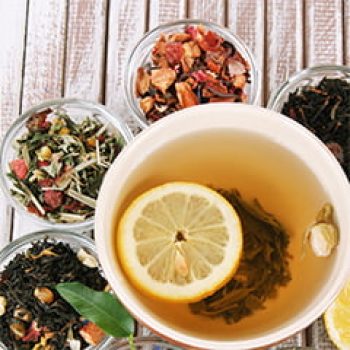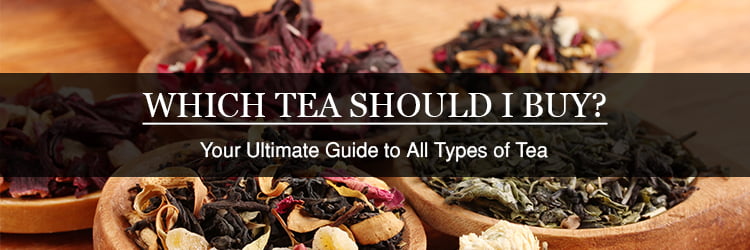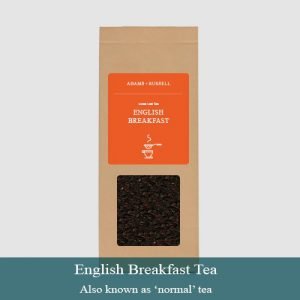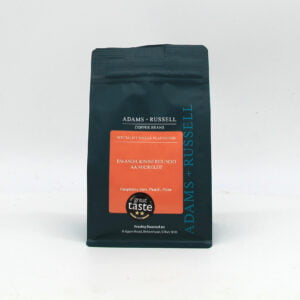Which Tea Should I Buy? A Guide to Buying the Best Loose Leaf Tea
- Updated on: March 7, 2024
- Written by: Aimee Bennett
Aimee is a coffee enthusiast and has worked in the coffee industry for years. She sources coffee beans from around the world and her coffee journey began in… (read more).


The world of tea can be a complicated one. Bags, loose, flowering, fermented… so many different types. Even we can get a little overwhelmed.
But it shouldn’t be stressful. It is simply wonderful, and should be enjoyed by everyone.
Do you know if you’re drinking the right tea for you? An ominous question.
How are you supposed to know if you’re drinking the right one? What even are the different kinds? Do they all have different brewing methods? Where are they from?
Ok, enough questions. Let us help you in your tea journey, we are here to help. In simple terms, we are going to break down all the different kinds and if you should be drinking them, where it comes from, how it is made and which has the most caffeine.
Once we have paired you with the right tea, we are going to explain exactly how you should be brewing it.
So, keep reading to reach tea enlightenment!

Where is Tea Grown and Harvested?
For this all to make sense, we must start at the beginning of the journey; the tiny seed.
Camellia sinensis is the scientific name for a tea plant. Cemellia coming from Latinized name of Rev. Georg Kamel and meaning ‘from China’ in Latin.
Tea can be likened to wine in that the flavour and quality is greatly determined by the climate it grows in. Acidic soil and heavy rainfall are the ideal conditions for the plants to grow.
The four biggest producers of tea are China, India, Kenya and Sri Lanka.
So how do these lush green plants become the small dried leaves we see in our bags? It’s not as complicated as you might think…
How is Tea Harvested?
Tea processing is the process in which the green leaves from the plant are turned into dried leaves for brewing.
Wikipedia goes into a lot of detail about the tea processing steps, however below I have summarised the steps that bring you your magical brew:
- Plucking – Leaves are usually picked from the plants twice a year. Hand picking is used for higher quality teas, whereas machines can be used for lower quality.
- Wilting – After picking, the leaves will soon begin to wilt. Wilting is great to remove the excess water from the leaves.
- Disruption – Where the leaves are bruised by being shaken in a bamboo tray to promote oxidisation. It also breaks down the structure of the leaves to bring out the flavour.
- Oxidisation/ Fermentation – The leaves are left in a climate controlled room as they turn darker, and in some cases they ferment.
- Fixation – Stopping the oxidisation as the desired level.
- Sweltering/ Yellowing – This process can take 6-8 hours. They are lightly heated in a closed container which turns the colour slightly yellow and gives a slightly mellow flavour.
- Rolling/ Shaping – The leaves are then rolled into tubes, spirals, balls, pellets or any other shape. This allows the oils and sap to come out which enhances the flavour.
- Drying – This can be panning, sunning, air drying or baking.
- Aging – this is optional, some teas require secondary fermentation or drying to reach their flavour potential.
Which Tea is Best for You?
This depends on three things: your needs, preferences and tastes.
Your needs. Do you suffer from anxiety? Are you trying to lose weight? Do you need help with sleep? There are lots of different teas which can help you with the specific issues you are having.
Your preferences. Do you prefer loose leaf? Or bags? Do you prefer stronger or weaker? No matter what the answer, there is something to suit everyone.
Your tastes. Is it sweet that you prefer? Or more savoury? Do you like fruit or would you rather herbal? The different flavours of tea are endless.
The Different Types of Tea
Tea People tells us that there are 5 basic different kinds of tea. These are:
Black
The most common type, accounting up for almost 85% of total tea consumption in the western world. It is fully oxidised and is dark in colour, strong in taste and has a high caffeine content.
Green
This is unoxidized to preserve a high level of antioxidants, vitamins and minerals, which is why it is so famous for its fantastic health benefits. It is pale green in colour and is a light drink with a slight nutty/grassy taste.
Oolong
This is semi-oxidised as it is only left for a couple of hours. The longer oolong is oxidised for the more it resembles black, whereas when it is not left for very long it is more similar to tea. It is a golden/ light brown colour with a delicate flavour.
White
The least processed of all, it is very light in colour and has a mild taste. It has a lower caffeine content than green and has a very high level of antioxidants.
Pu’er
All the way from Yunan in China. It grows on wild trees rather than cultivated bushes and is known for its Earthy flavour. It is fermented and can either be black or green depending on the level of oxidisation.
So, Which Tea Should I Be Drinking?
It all depends on your needs, preferences and tastes. If it is purely taste you are interested in, then you have lots of choice.
At Adams and Russell you will find 18 varieties of loose leaf tea. Below you will find a quick summary of all the flavours that we offer.
Fruity
- Lemon and Ginger Loose Leaf – Fresh lemon paired with warming ginger makes a combination that is hard to beat.
- Mixed Berries Infusion – Bright and beautiful with Hibiscus, Rosehip, Apple Pieces and Orange Peels.
Delicate and Flowery
- Redbush Rooibos – Nutty characteristics with a subtle touch of sweet orange.
- Earl Grey – Fragrant with a hint of spice and citrus.
- Jasmine – A green tea that is subtly sweet with added jasmine flowers.
- Camomile – Floral, delicate and wonderfully fragrant.
- Darjeeling – Known as the ‘champagne of teas’. Floral with a light spice.
Classic Breakfast
- Assam Loose Leaf – A distinctive malty flavour. Assam is one of three parts that makes up our loose leaf breakfast tea.
- Ceylon – Pungent with a touch of delicate flower. Also one of three parts that makes up our breakfast tea.
- English Breakfast – A national favourite. Blended from the finest Assam, Ceylon and Darjeeling leaves.
- Decaffeinated English Breakfast – Classic breakfast tea without the caffeine.
Refreshingly Minty
- Peppermint Loose Leaf – A delicious mint herbal tea that is naturally caffeine free.
- Moroccan Mint – A unique blend of gunpowder and mint tea.
Christmas in a Cup
- Christmas Black – A blend of Keenum and Ceylon that has flavours of baked apple, cinnamon, almond, star anise and vanilla pieces.
- Christmas Infusion – A rich, indulgent blend of dried rosehip and apple with hibiscus, ginger and citrus peel.
- Christmas Green – With Red Peppercorns and sugared snowflake crystals which resemble a holly bush, it not only tastes great but looks fantastic. Its flavours include clove, dark chocolate, brown sugar and toasted almonds.
Something a Little Different
- Lapsang Osprey Loose Leaf – A unique combination of sweet, clean, smoky flavours and a light tartness.
- Gunpowder Green – A smooth, smoky, nutty flavour. A green tea that is from Eastern China.
The Benefits of Tea for my Health
Tea is good for the mind, body and soul.
Different types will have different benefits, and you need to find which type is going to benefit you.
Some companies claim that their tea will cure you and make you into a new and improved version of yourself.
As much as we wish this were true, it is unfortunately not. It is most likely not going to cure an illness or give you a new purpose in life.
But, it is great for giving you that little boost you might need. Tea should be seen more as an assistant to aid your health, rather than a primary source.
In the next few paragraphs I am going to explain the fantastic ways in how it can assist your health.
Anxiety and Stress
- Peppermint – the menthol in peppermint is a natural muscle relaxant. Peppermint has a nice calming effect and the Adams and Russell tea is naturally caffeine free, which makes it a great option for an evening drink.
- Camomile – relaxes the muscles and reduces irritability. It also helps with insomnia, which can often be experienced when stressed or anxious.
- Green – we have lots of different kinds of green tea at Adams and Russell. The polyphenol it contains reduces anxiety and stress.
- Rose – The rosehip in our Mixed Berries Infusion is known to ease the mind and is great at reducing anxiety.
Weight Loss
Although tea will not directly make you lose weight, it can aid in weight loss when paired with a healthy diet and exercise. The best options for this are:
- Green – the catechins it contains have been proven to help trigger the release of fat cells.
- Mint – while some scents can trigger hunger, the smell of this type of tea has been shown to supress hunger.
- White – as it is the least processed type of tea, it is extremely rich in antioxidants. Studies have been carried out that show it helps with the breakdown of fat and can help to block the formation of fat cells.
- Redbush Rooibos – this contains Aspalathin which has been shown to reduce hormones that trigger fat storage.
Drinking Tea During Pregnancy
Many women are hesitant to drink tea during pregnancy due to all the warnings about caffeine, although coffee beans are generally more of a concern.
However, herbal infusions are perfectly safe and beneficial to drink when pregnant.
Keep reading to find out which will benefit you and which can reduce morning sickness.
- Is there anything it can’t do? It is caffeine free and contains magnesium, calcium and tons of antioxidants. It also helps with digestion and can reduce acid reflux.
- It has a lovely warming effect, but more importantly aids in digestion and can relieve stomach issues, kicking morning sickness to the curb.
- It will relax your stomach muscles and is great for reducing nausea.
Tea That Will Fight Cold and Flu
- Ginger – A comforting warming effect to combat the chill from a fever and it can help to relieve an upset stomach.
- Peppermint – Has a natural calming and numbing effect which will help headaches, nausea and congestion issues.
- White – This is packed full of antioxidants which will give your immune system that well needed boost.
How to Brew Loose Leaf Tea
Great, you have found the perfect tea, at last you have been united with ‘the one’.
But wait, there is still a chance that everything could be ruined.
You could brew it completely and utterly wrong. Which can quite literally ruin the taste of your tea.
It is nothing personal, it can happen to the best of us. That is why we are sharing our steps for ultimate brewing.
There is just one hurdle left until you are at the end of your magical tea journey, so let us guide you through it.
- Adams and Russell loose leaf tea is of the highest quality, so to maintain this standard we recommend a high quality teapot.
- For one person, one heaped tea spoon of leaves is all that is required. Our guide is one teaspoon for every 8oz (227g) of water.
- Put the leaves into the teapot and brew for 3-5 minutes, depending on how strong you would like it.
- Pour into your favourite mug. Enjoy on its own or customise your drink with adding milk, sugar or anything else you’d like to experiment with.







This Post Has 2 Comments
The teapot must be heated before tea is made. Put boiling water in it. Swirl. Leave a minute or so. Swirl. Empty. Add tea. Add just boiled wster.
My great grand mother insisted that the water for tea had to be freshly drawn and not reheated